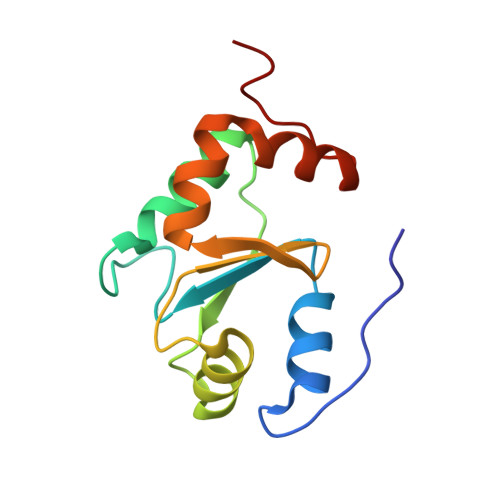[2Fe-2S] cluster transfer in iron-sulfur protein biogenesis.
Banci, L., Brancaccio, D., Ciofi-Baffoni, S., Del Conte, R., Gadepalli, R., Mikolajczyk, M., Neri, S., Piccioli, M., Winkelmann, J.(2014) Proc Natl Acad Sci U S A 111: 6203-6208
- PubMed: 24733926
- DOI: https://doi.org/10.1073/pnas.1400102111
- Primary Citation of Related Structures:
2MMZ - PubMed Abstract:
Monothiol glutaredoxins play a crucial role in iron-sulfur (Fe/S) protein biogenesis. Essentially all of them can coordinate a [2Fe-2S] cluster and have been proposed to mediate the transfer of [2Fe-2S] clusters from scaffold proteins to target apo proteins, possibly by acting as cluster transfer proteins. The molecular basis of [2Fe-2S] cluster transfer from monothiol glutaredoxins to target proteins is a fundamental, but still unresolved, aspect to be defined in Fe/S protein biogenesis. In mitochondria monothiol glutaredoxin 5 (GRX5) is involved in the maturation of all cellular Fe/S proteins and participates in cellular iron regulation. Here we show that the structural plasticity of the dimeric state of the [2Fe-2S] bound form of human GRX5 (holo hGRX5) is the crucial factor that allows an efficient cluster transfer to the partner proteins human ISCA1 and ISCA2 by a specific protein-protein recognition mechanism. Holo hGRX5 works as a metallochaperone preventing the [2Fe-2S] cluster to be released in solution in the presence of physiological concentrations of glutathione and forming a transient, cluster-mediated protein-protein intermediate with two physiological protein partners receiving the [2Fe-2S] cluster. The cluster transfer mechanism defined here may extend to other mitochondrial [2Fe-2S] target proteins.
- Magnetic Resonance Center and Department of Chemistry, University of Florence, 50019 Sesto Fiorentino, Florence, Italy.
Organizational Affiliation:
















